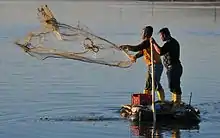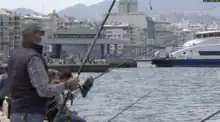


.JPG.webp)




In Turkey, fishing contributes 0.3% of the economy's total GDP as of 2002.[2] In 2018, the seafood sector provided employment to 52,937 people and produced 0.6 million tons of fish.[3] According to the OECD, this produced a value of USD 1,481 million.[3]
Turkey is surrounded by seas on three sides and has a coastline of 8,333 kilometres (5,178 mi), and its natural lakes make up approximately 10,000 km 2, with 3,442 km 2 of reservoirs, and 178,000 km rivers. Per capita fish consumption is low in Turkey despite being surrounded by seas.
Distribution
Geography
Fishing is carried out in the Turkish territorial waters of the Black Sea, Aegean Sea and the Mediterranean, in the Sea of Marmara and the straits (Bosphorus and Dardanelles) and inland waters. The coastline of Turkey, surrounded by seas on three sides, is 8,333 kilometres (5,178 mi). Territorial waters are 12 miles (19 km) out from the Mediterranean and Black Seas coastlines, and 6 miles (10 km) out in the Aegean Sea. The Marmara and the Turkish Straits with an area of 11,500 km 2 are considered Turkey's inland waters. Its natural lakes are approximately 10,000 km 2, with 3,442 km 2 of reservoirs, and 178,000 km rivers.[4] Fishing in the Aegean Sea is mainly coastal.[5]
Species
200 fish species live in the Sea of Marmara, 300 in the Aegean Sea, 247 in the Black Sea, and 500 in the Mediterranean. There are about 100 fish species that have economic value and are caught.[4] Commercially caught fish include anchovy, sardine, mackerel, bonito, sprat, haddock, bream mackerel, and bluefish.[6] Freshwater fishing includes ice fishing in Lake Çıldır.[1] Recreational fishing includes Mediterranean horse mackerel.[7]
Overfishing and climate change
The Black Sea is overfished but not as much as it was previously.[8] Anchovy stocks have decreased, with Ordu University Professor Mehmet Aydın blaming overfishing by Georgia.[9] The Mediterranean is overfished but not at lower levels compared to some years ago.[8] There is also Lessepsian migration from the Red Sea.[8]
Some fish have become extinct in the Sea of Marmara.[10] It has a problem of marine mucilage.[11]
The distribution of fish is changing due to climate change, for example flying gurnard have moved north into the Dardanelles.[12]
Domestic consumption
Per capita fish consumption is very low in Turkey, despite being on a peninsula surrounded by the sea on three sides. Annual fish consumption in Turkey is 8 kg,[13] the world average is 16 kg, EU average 26 kg.[14] The reasons for low fish consumption include a lower income level compared to other countries with larger seafood consumption, a high population with low domestic production, fluctuating seafood prices, and a strong cultural preference for fresh fish.[15]
In 2018, 600 thousand tonnes of fish (including molluscs and crustaceans) were produced, worth USD 1,481 million. 76% of this value came from aquaculture and 24% from fisheries. In 2018, twice as much was exported as imported: there were 15 thousand ships totalling 170 thousand tonnes 90% of which were shorter than 12 m.[3] Most government support was for management, control and surveillance and infrastructure.[3]
Aquaculture
Aquaculture, which started in the 1970s, has been supported by the government since 2003. Sea bass and sea bream are farmed, and mostly trout in inland waters.[16] Aquaculture overtook fishing in 2020, with Muğla, İzmir and Elazığ being the top provinces. In 2021, US$1.2 billion worth of farmed fish were exported.[13]
References
- 1 2 Nuh, Gunay (1 May 2021). "Eskimo-style ice fishing season begins in Turkey's east". Anadolu Agency (Anadolu Ajansı). Archived from the original on 14 March 2023. Retrieved 14 March 2023.
- ↑ The Organization for Economic Cooperation and Development. "Country Note on National Fisheries Management Systems -- Turkey" (PDF). OECD. Archived (PDF) from the original on 5 July 2022. Retrieved 17 March 2023.
- 1 2 3 4 "Fisheries and Aquaculture in Turkey" (PDF). OECD. Archived (PDF) from the original on 1 April 2022. Retrieved 12 March 2023.
- 1 2 Yaşar, Okan (2004). "Türki̇ye'de Su Ürünleri̇ Sanayi̇i̇ Ve Çanakkale İli̇'ne Yöneli̇k Bi̇r Değerlendi̇rme" (PDF). Marmara Coğrafya Dergisi (9): 1–32. ISSN 2147-7825. Archived from the original (PDF) on 9 July 2016. Retrieved 21 October 2015.
- ↑ "Comparison of technical measures in the Aegean Sea to support harmonization of fisheries management policies". public.pensoft.net. Archived from the original on 13 March 2023. Retrieved 13 March 2023.
- ↑ "Su Ürünleri İstatistikleri 2013". Tüik. 2013. Archived from the original on 6 May 2015. Retrieved 22 October 2015.
- ↑ Peksu, Murat; Uzer, Uğur; Yildiz, Taner; Ayaz, Adnan; Karakulak, F. Saadet (December 2020). "Hook selectivity and catch efficiency in two sport fishing sectors in the Strait of Istanbul, Turkey: Classic handline fishing and Light Rock Fishing (LRF)". Journal of Applied Ichthyology. 36 (6): 893–900. doi:10.1111/jai.14140. ISSN 0175-8659.
- 1 2 3 "The State of Mediterranean and Black Sea Fisheries 2022" (PDF). Food and Agriculture Organization. Archived (PDF) from the original on 13 March 2023. Retrieved 13 March 2023.
- ↑ "Anchovy stock depleting in Black Sea, expert warns - Türkiye News". Hürriyet Daily News. Archived from the original on 14 March 2023. Retrieved 14 March 2023.
- ↑ Ulman, Aylin; Zengin, Mustafa; Demirel, Nazli; Pauly, Daniel (2020). "The Lost Fish of Turkey: A Recent History of Disappeared Species and Commercial Fishery Extinctions for the Turkish Marmara and Black Seas". Frontiers in Marine Science. 7. doi:10.3389/fmars.2020.00650. ISSN 2296-7745.
- ↑ Karadurmuş, Uğur; Sari, Mustafa (2022). "Marine mucilage in the Sea of Marmara and its effects on the marine ecosystem: mass deaths". Turkish Journal of Zoology. 46 (1): 93–102. doi:10.3906/zoo-2108-14. ISSN 1303-6114. Archived from the original on 13 March 2023. Retrieved 13 March 2023.
- ↑ "Turkish fishers spot flying gurnard in Canakkale Strait". www.aa.com.tr. Archived from the original on 14 March 2023. Retrieved 14 March 2023.
- 1 2 "Agricultural Products Market: Aquaculture" (PDF). Ministry of Agriculture and Forestry (Turkey). Archived (PDF) from the original on 11 November 2022. Retrieved 21 March 2023.
- ↑ "Neden az balık yiyoruz?". haberturk.com. 12 April 2013. Archived from the original on 7 December 2015. Retrieved 21 October 2015.
- ↑ "Balıkçılık ve Denizel Ürünler Ekonomisi" (PDF). tarim.gov.tr. 2013. Archived from the original (PDF) on 8 October 2014. Retrieved 21 October 2015.
- ↑ "Su Ürünleri Özel İhtisas Komisyonu raporu" [Fisheries Specialization Commission Report] (PDF) (in Turkish). kalkinma.gov.tr. 2014. Archived from the original (PDF) on 14 July 2015. Retrieved 22 October 2015.